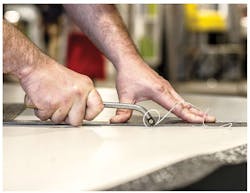Prevent Flooring Failures
The commercial flooring industry has undergone a dramatic shift over the past decade. New and emerging interior design trends coupled with the need for flooring that addresses acoustics, energy management, and maintenance requirements have changed the way the A&D community specifies flooring.
From the rise of LVT to create hospitality-like environments in healthcare facilities to the proliferation of carpet tile across multiple industry segments, designers have more design choices than ever. However, no matter how attractive a flooring installation is aesthetically, the subfloor and floorcovering material must provide building occupants with an appropriate level of performance and longevity. Failure to do this will end up costing clients time and money, ultimately creating plenty of headaches along the way.
how to get started: understanding the industry
The floor covering installation industry can be a confusing web of contractors, sub-contractors, and independent installers all vying for the same business. The most important thing to remember is that you get what you pay for.
While low bids can be attractive at first, A&D professionals and their clients deserve an installation team that is made up of trained and certified experts. Therefore it’s critical that the interior design community makes informed, long-term decisions about the products it is specifying and the installation methods used to complete projects.
Specific facility demands are what must dictate flooring selections, not simply colors, patterns, textures, and other design-centric factors.
anticipating problems: moisture, foot traffic, and rolling loads
One of the biggest issues facing commercial flooring installations in both new and retrofit projects is the presence of moisture in subfloors. When concrete slabs do not fully cure, excess moisture is trapped within the subfloor and will eventually be released. This first causes subfloors installed on top of the concrete to fail and will eventually lead to total flooring failure. Examples include:
- Carpet tiles: curling edges
- LVT: bleeding through joints and curling edges
- Sheet vinyl: blistering, discoloration, glue present at joints
- Hardwood: buckling and discoloration
- Laminate: bubbling and shrinkage
- VCT: cracking, telegraphing
While flooring contractors deal with moisture on a daily basis, especially in today’s fast-paced building and construction industry, not all are adequately prepared to test for and mitigate it. As moisture problems often don’t manifest for months after the installation, clients can eventually have a huge mess on their hands.
Once moisture has caused a flooring installation to fail, it can cost eight to 10 times the original project cost to replace. This is not only a significant cost for clients, but it is also an inconvenience, especially for healthcare and hospitality venues that operate in spaces that are always occupied.
Many leading voices within the floorcovering installation industry are passionate about moisture mitigation. “How can you go out and install floors and not understand or use moisture testing?” asked Marty Murdoch, executive vice president of INSTALL Warranty Contractor M.E. Sabosik Associates. “Moisture testing isn’t about making money; it’s about saving money for you and your client, and avoiding costly headaches in the future.”
While moisture mitigation will continue to be a major upfront concern for commercial flooring installations, subsequent foot traffic and rolling loads remain an important factor in product selection and installation methods.
The best selections for high-traffic areas depend on the current and future needs of a facility. Maintenance, static-resistance, and antimicrobial properties need to be addressed early in the design phase. Heat-welded sheet vinyl, LVT, rubber flooring, and bio-based tiles continue to be popular for healthcare facilities, for example, because they provide the right combination of performance attributes and can stand up to various traffic requirements.
While foot traffic is an issue for a variety of commercial spaces, heavy rolling loads are most common within healthcare facilities. Rolling loads are fundamentally different than foot traffic, which is widely distributed vertical pressure on the floor that often has little impact. If a corridor is constantly filled with hospital carts, x-ray machines, and gurneys (or another concentrated load that is exerting vertical and horizontal pressure at the same time), you need a strong bond between the floor and subfloor to keep it in place.
invest in the best: find the right contractor
It is clear that flooring failure can cost time and money, yet the A&D and building communities continue to make common mistakes. From specifying the wrong product to hiring untrained and uneducated contractors, these missteps lead to dissatisfied building occupants, and frustrated facility managers and owners.
In response to the significant need to raise awareness and aptitude of proper installation, organizations like INSTALL have created training curricula and certification programs covering moisture mitigation and remediation, floor preparation, and specific products such as carpet, resilient, and hardwood to eliminate flooring failure. For example, the organization’s Standard Skills and Resinous Flooring curriculum and the new Surface Prep Certification rely on collaboration between educators, contractors, and industry manufacturers.
“We are at a point right now where INSTALL contractors know what is expected and necessary for nearly every commercial installation project,” said Del Church, president of INSTALL Warranty Contractor Vortex Commercial Flooring. “Our team doesn’t take shortcuts. They know exactly what to do because they have the training and education to address the issues that could potentially ruin an interior designer or architect’s project. They are another set of eyes in the field.”
Making the right call on a project means choosing contractors that can help in selecting the right product and installation for the job.
John T. McGrath, Jr., is the executive director of INSTALL—the International Standards and Training Alliance—which is the construction industry’s best industry-endorsed floorcovering installation training and certification program. A three-decade flooring installation professional and accomplished speaker, McGrath conducts seminars regularly for architects, interior designers, building owners, and facility managers to increase their knowledge of flooring installation issues. He has been a featured presenter for AIA, IIDA, IFMA, and CSI professionals to help increase their knowledge and awareness of many floorcovering concerns. Learn more about INSTALL at installfloors.org.
